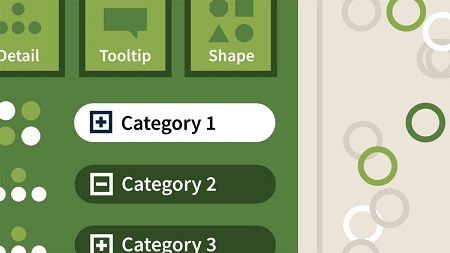English | MP4 | AVC 1280×720 | AAC 48KHz 2ch | 4h 19m | 650 MB
Tableau is a powerful and versatile data analytics and visualization tool that many consider indispensable for data science work. Its drag-and-drop interface makes it easy to sort, compare, and analyze data from multiple sources, including Excel, SQL Server, and cloud-based data repositories. In this course, learn how to analyze and display data using Tableau 2022—and make better, more data-driven decisions for your company. Instructor Curt Frye shows how to install Tableau, connect to data sources, and sort and filter your data. Curt uses real-world examples to demonstrate how to create and manipulate data visualizations—including highlight tables, charts, scatter plots, histograms, maps, and dashboards—and shows how to share your visualizations.
Table of Contents
Introduction
1 Apply the power of Tableau 2022 to your data
2 What you should know before starting
Introducing Tableau
3 Download Tableau
4 Install Tableau drivers
5 Introduce Tableau file types
6 Get help in Tableau
Managing Data Sources and Visualizations
7 Connect to a data source
8 Join related data sources
9 Join data sources with inconsistent field names
10 Clean up source data
11 Reorder fields in a visualization
12 Change the summary operation
13 Split text into multiple columns
Managing Tableau Worksheets and Workbooks
14 Display the data underlying a workbook
15 Add, duplicate, and rename worksheets
16 Reorder, clear, and delete worksheets
17 Change a worksheet’s tab color
18 Show or hide worksheet elements
19 Save your changes
20 Save your workbook as a PDF file
21 Create a packaged workbook
22 Export data to a CSV file
23 Export visualizations to PowerPoint
Creating Custom Calculations and Fields
24 Present Tableau operators and built-in functions
25 Create a calculated field
26 Create a calculated field on a shelf
27 Add a table calculation
28 Use level of detail expressions
29 Create calculations in dialog boxes
Analyzing Data
30 Calculate averages, medians, minimums, and maximums
31 Count occurrences and distinct items
32 Display the Summary Card
33 Calculate percentages within a table
34 Forecast future values
Sorting and Filtering Tableau Data
35 Sort based on a field’s values
36 Create a nested sort
37 Create a selection filter
38 Create a wildcard filter
39 Create a condition filter
40 Create a top filter
41 Edit, clear, and delete filters
42 Filter data using parameters
43 Edit and delete parameters
Defining Groups and Sets
44 Define a group
45 Define a group for other values
46 Find members of a group
47 Edit and delete groups
48 Define a set
49 Create summaries using sets
50 Combine sets
51 Edit and delete sets
Creating Basic Visualizations
52 Create column and stacked column charts
53 Create line charts and area fill charts
54 Create pie charts
55 Create scatter plots
56 Identify data clusters
57 Create histograms
58 Summarize data using a smart histogram
59 Create a treemap
Formatting Tableau Visualizations
60 Change the visual summary type
61 Change the appearance of your data
62 Set a default format for a field
63 Display a visualization in Presentation mode
64 Create a highlight table
65 Display a viz in a tooltip
Annotating and Formatting Visualizations
66 Annotate a visualization
67 Format chart elements
68 Change the order of fields in a visualization
69 Add a trend line to a chart
70 Add reference lines and quartile indicators
Mapping Geographic Data
71 Create a basic map
72 Add and remove map layers
73 Enhance map analysis using distance measurement tools
74 Disable pan and zoom in maps
75 Define custom regions
Creating Dashboards and Actions
76 Present data using Storylines
77 Create a dashboard
78 Arrange and resize dashboard elements
79 Replace a worksheet in a dashboard quickly
80 Define a filter action
81 Define a highlight action
82 Define parameter actions
Conclusion
83 Further resources for Tableau
Resolve the captcha to access the links!
